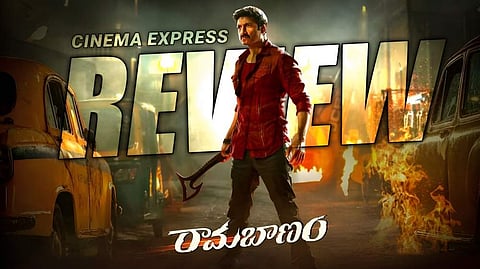Rama Banam Movie Review: A middling masala entertainer
Rating:(2.5 / 5)
‘Something old, something new, something borrowed, something blue’, a phrase traditionally used for American brides can be strangely but suitably applied to Gopichand’s latest feature, Rama Banam. There is a lot in Rama Banam that is reminiscent of the 2000s “family audience” cinema, the viluvale maa aasthi-subgenre a younger demographic, including yours truly, love to ridicule. The film also tries to infuse new elements in the film, though I have a hard time believing the presence of a GoPro-toting vlogger (Dimple Hayathi) can succeed at facelifting a story so comfortable in its geriatric virtue signaling. Rama Banam, complete with blue comedy tracks where slap scenes and gay jokes incite half-hearted chuckles, leaves its viewers with two strong emotions. One, is of irony and incessant eye-rolls at how some things in Telugu cinema never really change. The other, of satisfaction and comfort, the result of a safe bet on paper living up to its reputation of being safe and of being a good bet.
Cast - Gopichand, Dimple Hayathi, Khushbu, Jagapathi Babu
Director - Sriwass
Rama Banam plays with dualities convexing and concaving throughout its runtime. At the heart of its story is the relationship between brothers Rajaram (Jagapathi Babu) and Vicky (Gopichand), personifications of prakruthi and pralayam, respectively. Vicky runs away from his family to Kolkata, only to return after fourteen years, all rich (check) and criminal (double check). The quirky sight of folks eating dhoklas in Kolkata and Rosogollas in Hyderabad is quickly offset by the film’s amusingly inconsistent accents. The Bengalis in the film talk like North Indians, while the North Indians in the film talk like Dakhni people. Each brother has a secret set of enemies, who bay for the blood of these brothers separately till they learn that they can unite, become each other’s friends, and take down these blood brothers. There is a smaller, more intimate theme in Rama Banam with large-scale implications (righteousness, family above all) competing for your attention alongside a large-scale issue (food adulteration, malpractices et al) making its presence felt through some small but sustained metaphors. Microeconomics and Macroeconomics…if I may say so.
While some aspects in the film clearly work against its favour, be it the three unmemorable romantic numbers shot in vaguely international locations or its unconvincing, miscast antagonists, Rama Banam also falters heavily due to its largely counterproductive approach of elevating its hero without enough conflict or consequences. For instance, when Vicky returns to his family after 14 years, it is not because he misses them, it is because his girlfriend’s family did not want her to get married to an orphan. His brother and sister-in-law find out and instead of feeling betrayed, they go on to heap praises on the girl for reuniting the family. The action sequences in the film are more slippery than slick, be it with goons falling down to coordinated music or with guns just rolling backwards into Gopichand’s hands, Tenet-style. While I understand it is crucial to elevate the hero at any chance you get, the elevations need to possess an element of delayed gratification in its treatment, lest you risk taking your audience for granted. The treatment of the film is functional at best, with us wishing the film took the extra mile by boomeranging hard off its core mass material. Bobby Kolli’s Waltair Veerayya, for one, is a great example of the same.
The cinematography of Rama Banam, by Vetri Palanisamy, is noteworthy for a host of reasons. It is not surprising that he is also the cinematographer of Viswasam and Annaatthe, considering he paints the frames of Rama Banam with the same bright, festive colours, in sync with the film’s spirit. There is a scene in the first half of Rama Banam, where the hero’s two sidekicks in a comedy sequence are confused about who the director and the cameraman amongst them is (they are shooting a YouTube video). One can’t help but wonder sometimes, if Vetri took the director’s chair in Rama Banam, considering his innumerable rack focus shots and drone shots take over the story with wild abandon. There is also some uncharacteristic found footage work in this film. All of this creates for a jarring yet fun experience. It might be a long time before we see yet another masala film adopt such a distinct, laissez-faire approach with its cinematography, truth be told.
Rama Banam really shines when the conflict between Rajaram and Vicky is cracked wide open. It not only adds some necessary tension to the film’s proceedings but also ties the rest of the film together neatly. Rama Banam puts two paths of righteousness, one of peace and the other of violence, at odds with each other. The film answers its question quickly too, reinforcing the position that it is better to be a warrior in a garden rather than a gardener in a war. While the Rama stands for righteousness, the Banam represents the film’s preferred mode of righteousness. Jagapathi Babu shines as Rajaram, adding yet another role to keep the Prakash Raj-ification of his career going, one character role at a time. Khushbu is yet another solid addition to the film’s supporting cast. So is Ali, as this film’s voice of reason and audience surrogate.
In an age when people are often quick to remark whether a film is a theatre watch or an OTT one, I have two words for Rama Banam. Goldmines watch.

